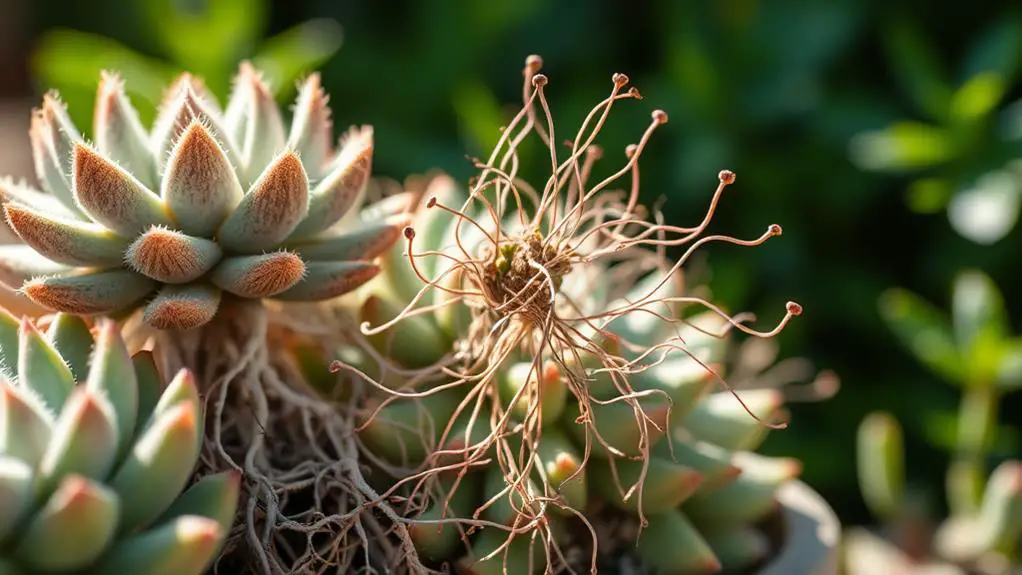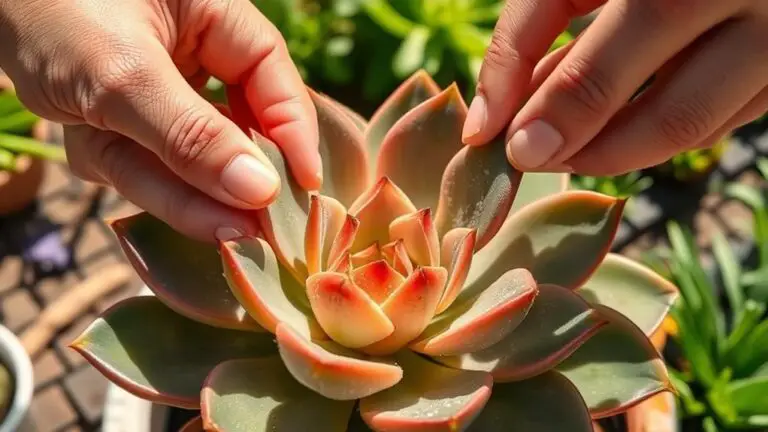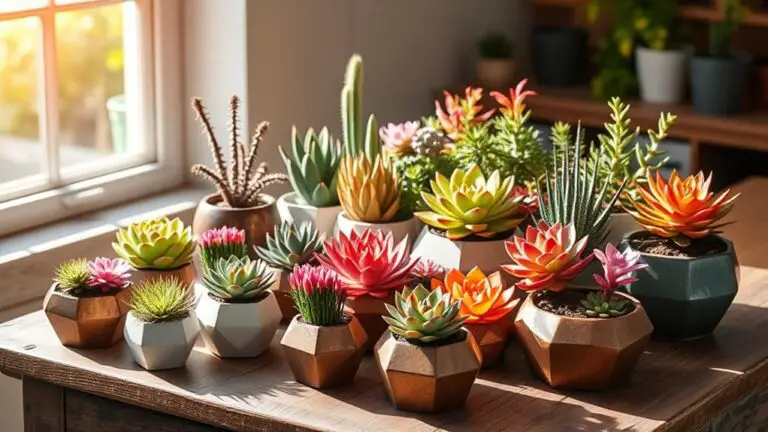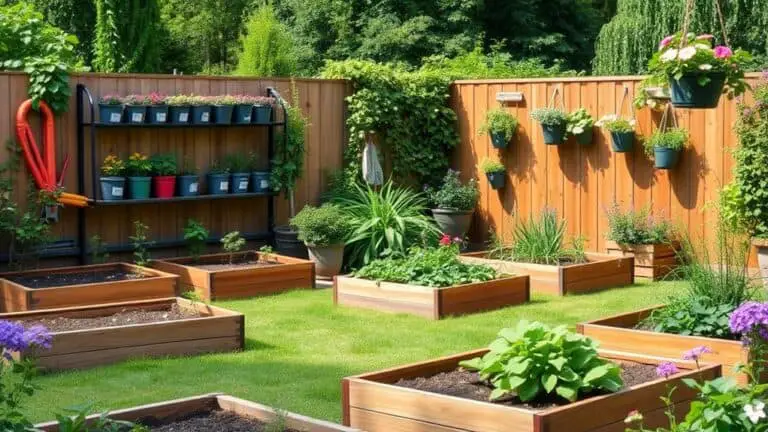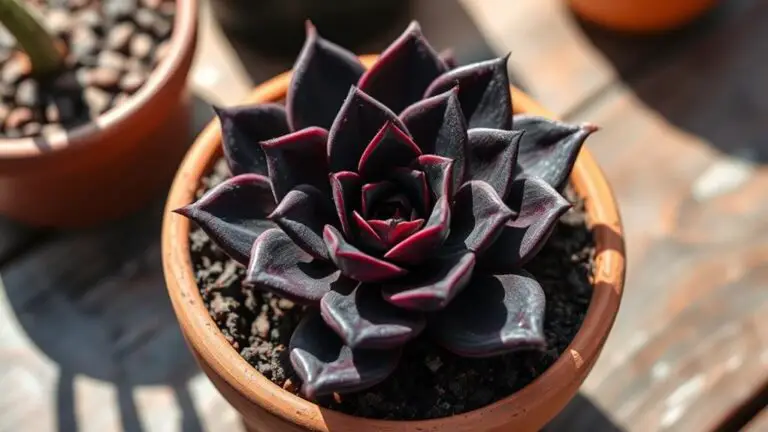Aerial Roots on Succulents: What Are They?
Have you ever noticed those unusual roots growing above the soil on your succulents? These are called aerial roots, and they're more than just a quirky feature. They often appear when your plant is facing challenges like dehydration, low light, or high humidity. Understanding why and how these roots develop can help you better care for your succulents, ensuring they thrive. So, what exactly do these roots do, and how can you manage them effectively to maintain your plant's health? Let's explore the fascinating world of aerial roots and their impact on your succulents.
Understanding Aerial Roots
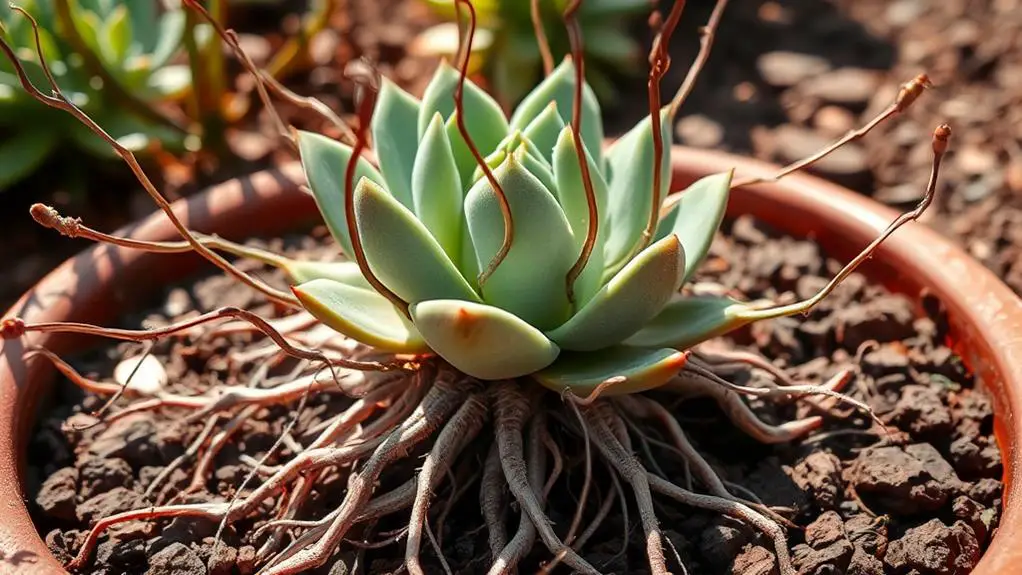
Understanding aerial roots on succulents involves recognizing their unique role and appearance. These roots grow above the ground and can be light pink, white, or eventually turn brown and dry out. They're a sign that your succulent is trying to adapt to its surroundings.
When you see aerial roots, it often means the succulent needs water or is facing environmental stressors like underwatering, high humidity, insufficient sunlight, or poor soil drainage.
Aerial roots can be your succulent's way of saying it's thirsty. If your plant doesn't get enough water, it will try to absorb moisture from the air through these roots. Similarly, if the light is too dim, the plant might grow aerial roots to seek out better conditions. This is a cue for you to check if your succulent needs more sunlight or better watering habits.
While aerial roots are typically harmless, they can be trimmed if you don't like how they look. Just be sure to keep an eye on your plant's health afterward.
Regular monitoring helps guarantee you're meeting its needs and addressing any issues promptly. By understanding these signals, you can provide better care and help your succulent thrive.
Functions of Aerial Roots
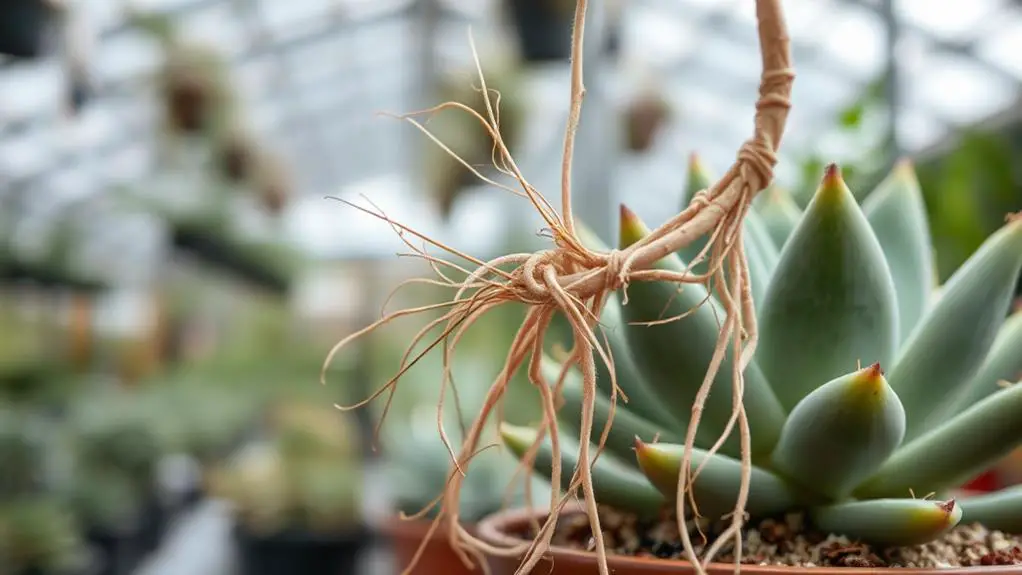
Aerial roots on succulents play important roles in helping your plants thrive. They absorb moisture and nutrients from the air, which is super useful in humid areas where soil might be too dry.
These roots also help with plant support and make propagation easier by giving cuttings the boost they need to grow.
Moisture Absorption Mechanism
Succulents possess a unique adaptation in the form of aerial roots, which play an essential role in moisture absorption. These aerial roots absorb moisture from the air, especially in humid environments, helping the plant get water when the soil is too dry.
Here's how they do it:
- Small Pores: Aerial roots have tiny pores that let them take in air and water from the atmosphere. This is super useful when the soil is waterlogged, as it helps the plant breathe better.
- Extra Water Source: In dry times, these roots act as a backup water system, making sure your succulent stays hydrated even when the soil isn't cooperating.
- Adaptive Response: Aerial roots grow in response to stress, like low soil moisture, ensuring your plant can still thrive in tough conditions.
Structural Plant Support
The remarkable function of aerial roots in succulents goes beyond moisture absorption; they also provide essential structural support. These unique roots help anchor the plant to nearby surfaces or the soil, giving it the stability it needs to thrive.
When aerial roots come into contact with soil, they can grow downward, reinforcing weaker stems and preventing them from toppling over. This makes the plant more robust and better able to handle its environment.
Aerial roots aren't just about stability, though. They also enhance the plant's ability to absorb moisture and nutrients from the air. This is especially important in humid environments where soil moisture may be limited.
So, not only do these roots keep your succulent upright, but they also help it stay hydrated and nourished.
You might notice aerial roots developing when your succulent faces challenges, like instability or limited moisture. This adaptability shows just how resourceful these plants can be.
By understanding the role of aerial roots in providing structural support, you can better care for your succulents and create an environment where they can thrive.
Keep an eye on those roots—they're a sign your plant is working hard to grow strong and healthy.
Propagation Assistance
Beyond providing stability, aerial roots play a pivotal role in the propagation of succulents. These roots aren't just for show; they're key players in helping new plants grow.
Here's how aerial roots contribute to propagation:
- Absorb Water and Nutrients: Aerial roots help cuttings absorb moisture and nutrients from the air. This ability enhances their chances of successful growth when detached from the parent plant. Think of it like giving your succulent babies a head start!
- Soil Contact and Support: When aerial roots touch the soil, they grow downwards, providing additional support for new plantlets. This helps them establish a stronger foundation, ensuring they're more stable and healthy.
- Offset Growth: Some succulents, like Kalanchoe and Sedum, produce offsets with aerial roots. These offsets can spread and create new plants in their natural habitats, making your garden flourish with minimal effort.
Aerial roots also signal to the plant when it needs to propagate due to environmental stress or competition for resources.
By forming these roots, succulents can increase their propagation potential, especially in challenging environments.
Causes of Aerial Roots

Succulents can grow aerial roots due to dehydration, signaling they're struggling to get enough moisture from the soil.
Environmental stressors like temperature changes and lack of sunlight can also cause these roots to form, helping the plant adapt to challenging conditions.
Dehydration and Moisture Needs
Ever wondered why your succulents suddenly sprout aerial roots? It's often a sign that they need more water. When a succulent develops aerial roots, it's usually trying to absorb additional moisture from the air because the soil isn't providing enough.
Here are a few reasons this might happen:
- Dehydration: If your succulent's soil is too dry, especially during dormancy periods in winter or summer, the plant may start growing aerial roots. These roots help it capture moisture vapor from the air.
- High Humidity: Surprisingly, high humidity can also cause aerial roots. If the soil lacks adequate moisture, succulents will try to capture water from the humid air around them.
- Poor Drainage: When soil doesn't drain well, it can stress the plant's traditional roots. This stress can lead to the growth of aerial roots as the succulent seeks moisture from the surrounding air.
To prevent aerial roots, monitor your succulent's environment closely. Guarantee the soil has good drainage and keep an eye on humidity levels.
Proper care will help your succulent stay healthy and reduce the need for these moisture-seeking roots.
Environmental Stress Factors
Your succulent's aerial roots are often a telltale sign of environmental stress factors at play. Understanding these factors helps you address the root cause and guarantee your plant thrives. One primary cause is underwatering. When your succulent doesn't get enough water, it tries to absorb moisture from the air, leading to the formation of aerial roots.
Increased humidity can also prompt aerial roots. When the air is more humid than the soil, succulents adapt by growing aerial roots to absorb that moisture. Lack of sunlight is another stress factor. If your succulent isn't getting enough light, it may stretch and produce aerial roots for support, as it searches for better light conditions.
Poor soil drainage is another culprit. When the soil retains too much water, it affects root health and oxygen availability. As a result, your succulent may grow aerial roots as a survival mechanism. Finally, environmental stress factors like dehydration and root issues can stimulate the growth of aerial roots, helping your plant cope with challenging conditions.
| Cause | Effect | Solution |
|---|---|---|
| Underwatering | Seeks moisture from air | Increase watering frequency |
| Increased Humidity | Adapts to absorb moisture | Guarantee balanced humidity |
| Lack of Sunlight | Stretches for support | Provide more light |
| Poor Soil Drainage | Compromised root health | Improve soil drainage |
| Dehydration | Survival adaptation | Regular watering schedule |
Signs of Plant Health
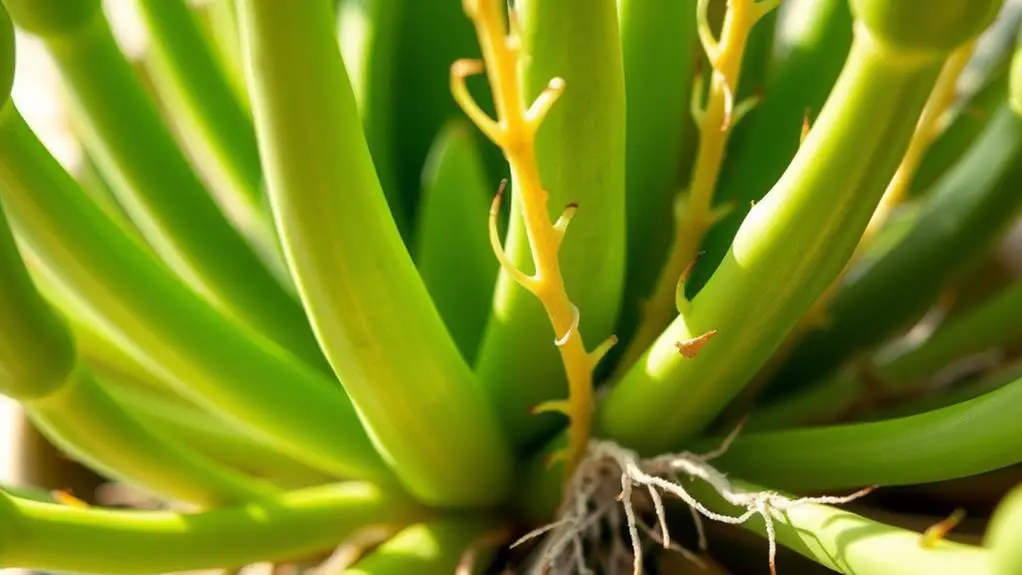
When aerial roots appear on your succulents, they often signal essential aspects of the plant's health.
These roots can be a helpful indicator of what your succulent needs to thrive. Here's what you should look for:
1. Moisture Levels: Aerial roots frequently form when your succulent is thirsty. If you notice wrinkled or shriveled leaves, it's a sign that your plant is struggling to find enough water.
These roots are trying to absorb moisture from the air to compensate.
2. Humidity Adaptation: If you live in a humid area, aerial roots can signal that your succulent is adapting well.
They're reaching out to collect extra moisture from the environment, showing that your plant is responsive and resilient.
3. Light Conditions: Inadequate sunlight can also cause aerial roots to develop.
If your succulent starts to stretch and produce these roots, it might be crying out for more light. Ensuring your plant gets enough sunlight is vital for its growth and overall plant health.
Watering Guidelines
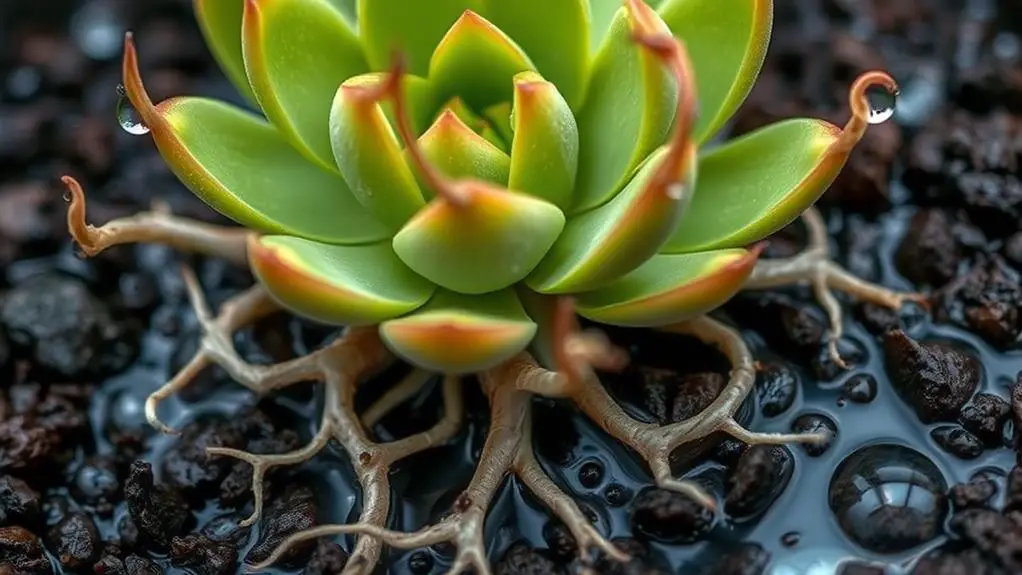
Proper watering is vital for maintaining the health and vigor of your succulents. You'll need to follow specific watering guidelines to keep their roots happy and prevent root rot.
During the summer months, water your succulents every 7-10 days. Make certain the top 1-2 inches of soil dry out completely before you water again. This prevents overwatering, which can harm your plants.
In the winter, reduce your watering frequency to every 3-4 weeks. Succulents enter dormancy during this time and need less moisture. When you do water, make sure to water deeply. Light spritzing isn't enough. Deep watering guarantees the roots get the moisture they need to thrive.
Using pots with drainage holes is essential. These holes let excess water escape, preventing root rot and other moisture-related problems.
If you're unsure about when to water, consider using a water meter. It helps you accurately gauge the soil moisture levels, so you can stick to an appropriate watering schedule.
Nutrient Needs
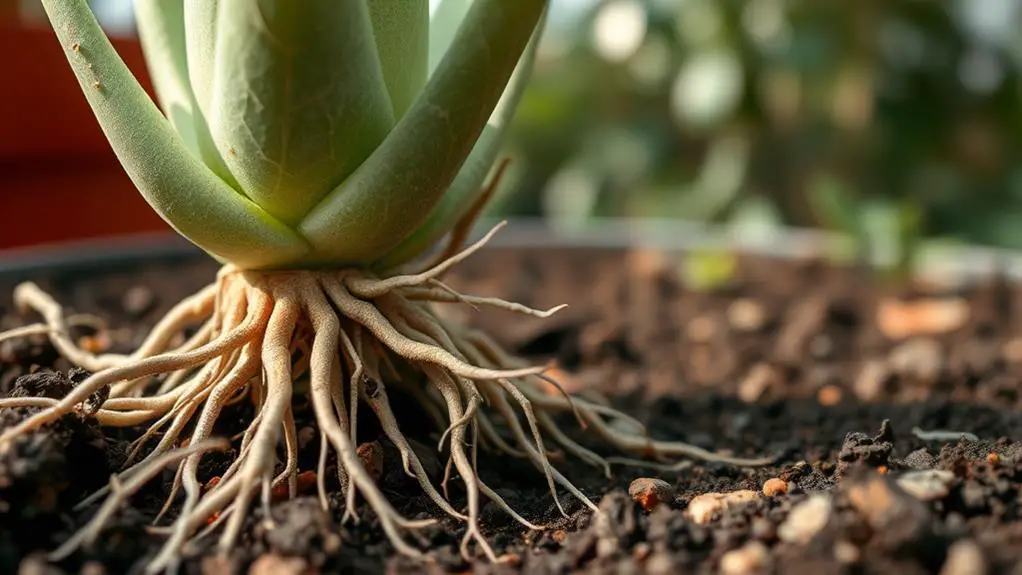
To keep your succulents happy, you need to focus on their nutrient needs.
Use a cactus fertilizer monthly during spring and summer to help them absorb essential nutrients.
Also, remember to re-pot them every few years to refresh the soil and supply fresh minerals.
Essential Nutrient Absorption
Succulents' health hinges on essential nutrients like nitrogen, phosphorus, and potassium, which are critical for their growth and development.
For ideal essential nutrient absorption, it's important to focus on the roots growing in well-draining soil. This type of soil prevents water logging, allowing roots to efficiently absorb nutrients without the risk of root rot.
Here are three tips to help your succulents absorb nutrients better:
- Re-potting: Every few years, re-pot your succulents to refresh the soil nutrients. This guarantees they've access to a rich nutrient source, which is essential as they grow.
- Growth Period: Pay attention to your succulent's active growth periods in spring and summer. During these times, they're more efficient at nutrient uptake, so provide extra care.
- Soil Choice: Always use well-draining soil. This prevents water from lingering around the roots, which can lead to rot and hinder nutrient absorption.
Fertilization Best Practices
When it comes to fertilizing succulents, timing and the right type of fertilizer make all the difference. Succulents thrive with monthly fertilization during their active growing seasons of Spring and Summer. Using a cactus fertilizer, which is low in nitrogen and high in potassium and phosphorus, promotes healthy growth and flowering.
It's essential to choose well-draining soil to prevent water logging, as excess moisture can lead to root rot and hinder nutrient absorption. Re-potting your succulents every few years refreshes soil nutrients, making sure your plants remain healthy and vibrant.
Here's a quick reference table to help you with fertilization best practices:
| Step | Description |
|---|---|
| Timing | Fertilize monthly during Spring and Summer. |
| Fertilizer Type | Use cactus fertilizer with low nitrogen, high potassium, and phosphorus. |
| Soil Choice | Always use well-draining soil to prevent root rot and nutrient absorption issues. |
| Re-potting | Re-pot every few years to refresh soil nutrients. |
Monitoring your succulent's nutrient levels and adjusting fertilization frequency based on their growth rate and condition can enhance overall plant health. By following these steps, you'll guarantee your succulents grow strong and healthy. Happy gardening!
Light Requirements
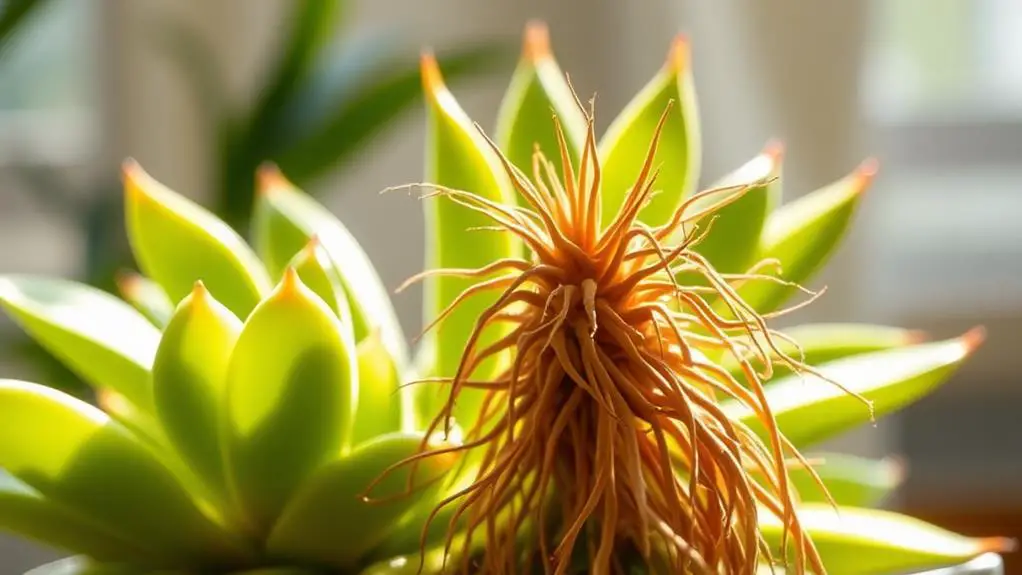
Aerial roots on succulents are often a clear signal that your plants aren't getting enough light.
Succulents need bright light to thrive and avoid developing aerial roots. When they don't get enough light, they start to stretch towards any available light source, which can lead to leggy growth and the formation of aerial roots.
To guarantee your succulents meet their light requirements, follow these simple steps:
- Assess Light Conditions Regularly: Check the amount of light your succulents receive throughout the day. If you notice they're not getting enough, consider moving them to a brighter spot.
- Position in Well-Lit Areas: Place your succulents in areas where they can get plenty of sunlight. South-facing windows are usually the best, as they provide the most consistent light.
- Monitor Plant Health: Keep an eye on your succulents' growth patterns. If they start looking leggy or develop aerial roots, it's a sign they need more light.
Managing Aerial Roots
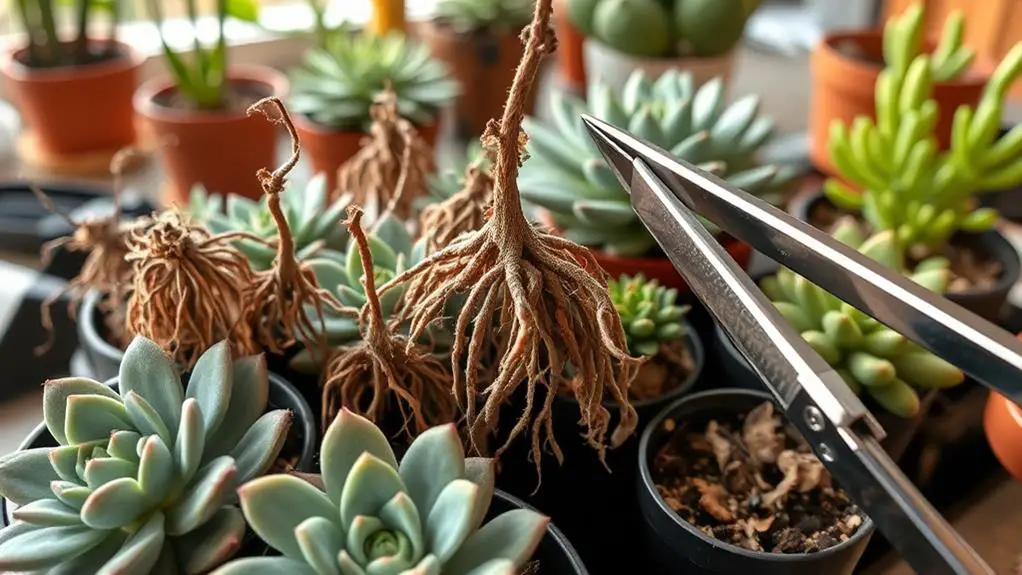
Managing aerial roots on succulents is vital for maintaining their aesthetic appeal and overall health. If you find the appearance of aerial roots undesirable, you can trim or pluck them. However, before you do, check the plant's health to verify it's not stressed. Regularly monitor your succulent afterward to make certain it stays healthy and stress-free.
A key step to manage aerial roots is proper watering. Deep watering helps address the root causes of these roots developing. Make certain you don't overwater, as this can lead to excess moisture retention, which might cause other problems. Balancing water intake is essential.
Another important tip is to relocate your succulents to well-ventilated areas. Controlling humidity levels can help reduce unnecessary aerial root growth. Proper air circulation can make a big difference.
Recognizing aerial roots can also be a sign that adjustments in care are needed. For example, your succulent might need more light exposure or improved soil drainage. Paying attention to these signs can help you manage aerial roots effectively.
Additional Care Tips
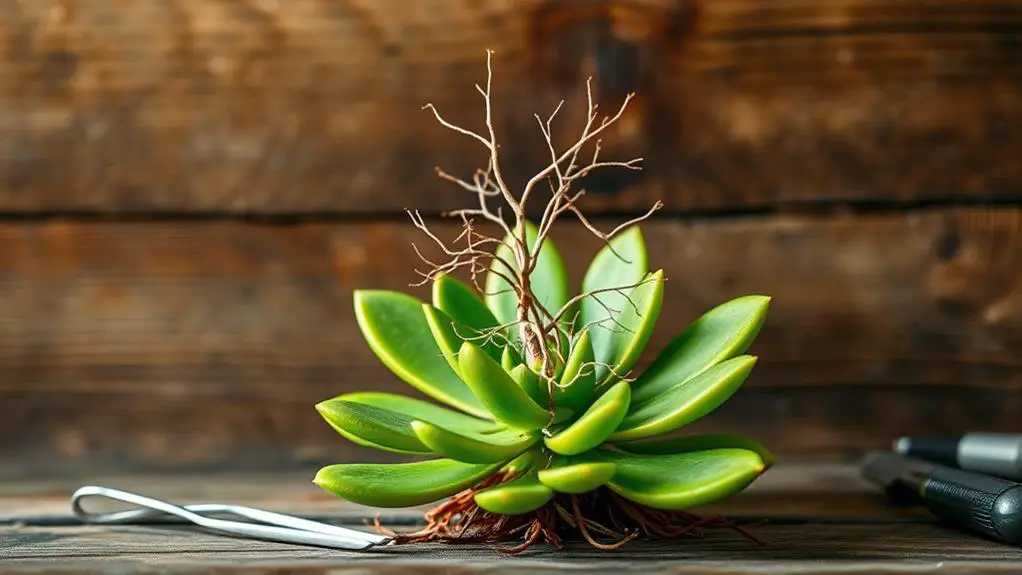
Why should you care about additional tips for succulent care? Because understanding and applying these tips can help you keep your succulents healthy and thriving, even if they develop aerial roots.
Let's explore some practical steps you can take.
1. Watering Schedule: Water your succulents every 7-10 days during summer and every 3-4 weeks in winter.
Let the top 1-2 inches of soil dry out before the next watering. This helps prevent overwatering and root rot, both of which can cause aerial roots on succulents.
2. Soil Choice: Use well-draining soil specifically designed for succulents.
This type of soil guarantees that moisture doesn't accumulate around the roots, keeping your plants healthy and less prone to developing aerial roots due to excess water.
3. Sunlight Management: Gradually shift your succulents to brighter locations to avoid a lack of sunlight.
Insufficient light can cause weak, leggy growth, leading to aerial root formation. If natural light is limited, consider using grow lights to provide the necessary light for the best growth.
Popular Succulents With Aerial Roots
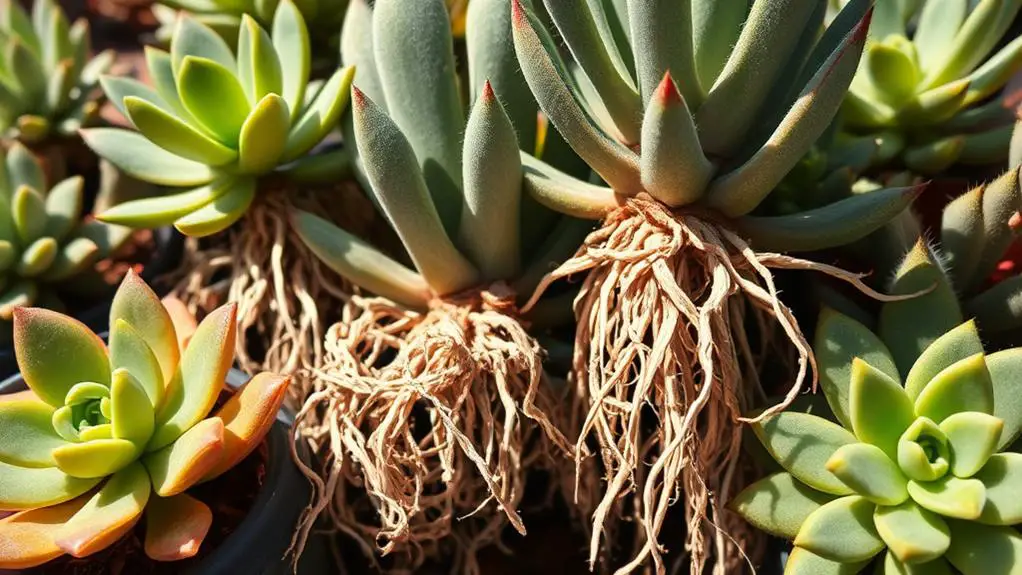
Succulents are fascinating plants, and some of the most popular varieties are known for developing aerial roots. If you're growing Echeverias, you might notice these roots as a sign of health and adaptation. They form to help the plant absorb moisture and nutrients from the air.
The Jelly Bean Plant, or Sedum rubrotinctum, often develops aerial roots when it experiences moisture stress or needs extra support. These roots help the plant stay healthy and stable.
Kalanchoe varieties, like Kalanchoe blossfeldiana and Kalanchoe tomentosa, also commonly display aerial roots. They use these roots to enhance moisture absorption and maintain structural stability.
Echeveria agavoides and Sedum morganianum, also known as Donkey's Tail, produce aerial roots when reaching for light or during propagation. This is a common problem for many succulents, but it shows their adaptability to environmental changes.
Quick-growing succulents, like Kalanchoe fedtschenkoi, often have these roots as well.
Understanding why your succulent develops aerial roots can help you provide better care. These roots indicate that the plant is trying to adapt and thrive in its environment. So, don't worry—it's just your succulent's way of staying healthy!
Frequently Asked Questions
Should I Remove Aerial Roots From a Succulent?
You don't have to remove aerial roots from your succulent since they're harmless and help with moisture. If you don't like their appearance, trim them carefully with clean scissors. Keep an eye on the plant's health after trimming.
Why Does My Succulent Have Air Roots?
Your succulent has air roots due to factors like dehydration, high humidity, insufficient sunlight, poor soil drainage, or environmental stress. These roots help the plant access moisture and nutrients, adapting to its surroundings for survival.
How to Propagate Succulent With Air Roots?
To propagate your succulent with air roots, cut a healthy stem with roots. Plant it in well-draining soil, water lightly, and keep it in bright, indirect sunlight. Monitor for new growth to guarantee successful propagation.
Why Is My Plant Growing so Many Aerial Roots?
Your plant's growing so many aerial roots likely due to environmental stress like insufficient watering, poor light, or high humidity. It's adapting to seek moisture, support, or oxygen. Check its care conditions to address the specific issue.
Conclusion
Taking care of succulents with aerial roots is easier than you might think. By understanding why these roots form and adjusting your watering and light routines, you can help your plants thrive. Keep an eye on those roots and make small changes to support your plant's health. You've got this! With a little attention and care, your succulents will continue to grow strong and beautiful. Happy gardening!

